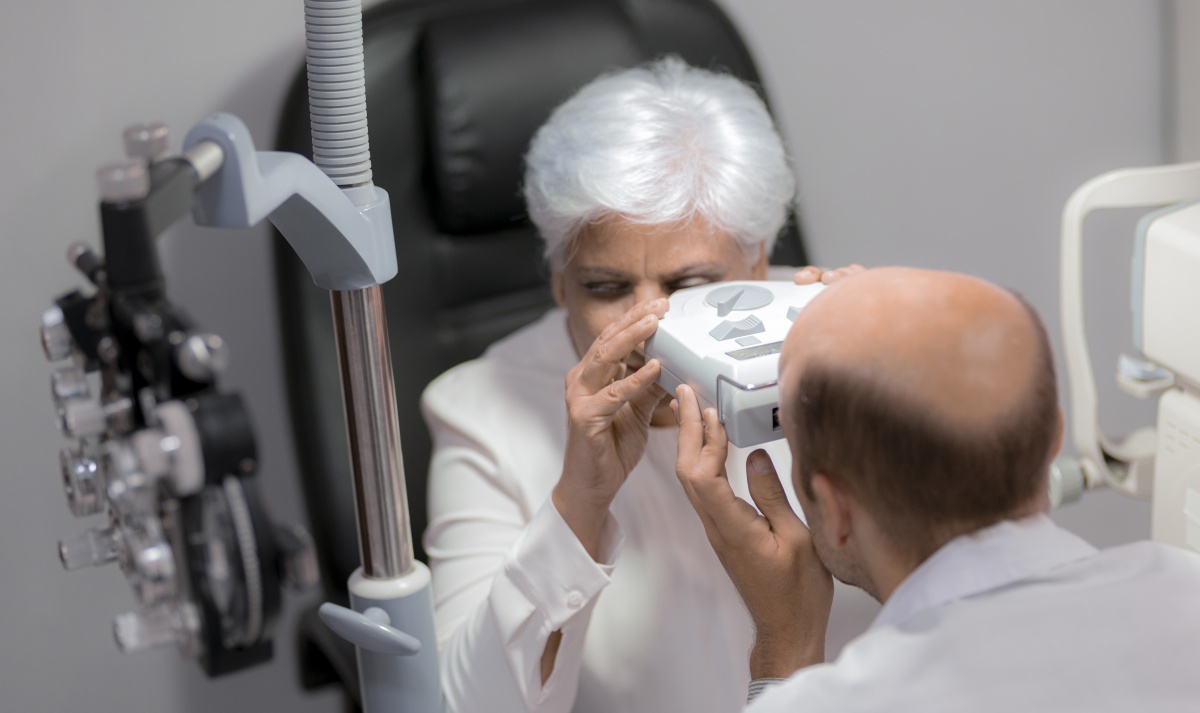Download PDF Version: Out of the Box Optometry: The Power of Onsite Vision Care Within Skilled Nursing Facilities
Traditional office-based eye care poses challenges for both staff and residents of skilled nursing facilities. When individuals must be taken offsite, barriers to optimal care often crop up. Transportation challenges, individuals’ adverse reactions to unfamiliar environments, and limited provider experience with memory care patients are obstacles. Often, the result is episodic, insufficient treatment that has significant implications for resident well-being.
Aria Care Partners believes compassionate, comprehensive, and convenient vision care delivered at the skilled nursing facility is the best solution. This onsite service should follow a three-pronged approach:
- Vision treatment. Vision loss affects more than 37 million Americans older than 50.[1] Four in ten U.S. adults at high risk for vision loss have not had an eye exam in at least 12 months.[2] And common age-related eye disorders heighten fall risk. These statistics underscore the urgency of consistent quality vision care for all skilled nursing facility residents. Onsite assessments, regular care reviews, and appropriate treatments help preserve vision, mitigate complications, and manage related health concerns. Adjusting eyeglass prescriptions when needed can restore functional sight.
- Side effect awareness. The risk of hospitalization due to a fall increases with polypharmacy, the common scenario in which individuals are consuming several daily medications.[3] Falls may be partially induced by drug side effects that negatively impact the eye such as pain, blurred/double vision, spatial awareness changes, and retina swelling or damage. Onsite vision care enables skilled nursing facilities to spot, monitor, and manage drug side effects that threaten eye health.
- Daily care recommendations. Aria Care Partners’ external providers function as a coordinated extension of the internal care team. They strengthen staff’s understanding of common eye diseases and provide advice grounded in information from the in-house team. Such collaboration optimizes holistic onsite care for greatest resident benefit. Simple but fruitful care tips such as warning patients with glaucoma of door jambs and encouraging those with age-related macular degeneration to use assistive devices can make a meaningful difference.
Onsite and ready with all the right tools
Effective onsite vision care requires a different approach from that provided in typical office or retail eye exam settings. At Aria Care Partners, we call this “Out of the Box Optometry.” It means showing up at the SNF prepared to address a diverse set of eye care needs using carefully curated equipment, state-of-the-art techniques, and well-honed skills. This model promotes quality vision care for residents in the comfort of the familiar facility setting.
Four key components characterize Out of the Box Optometry:
- Mobile instrumentation: Vision care professionals bring all necessary equipment and supplies to the facility to conduct comprehensive eye exams, proactive eye-disease detection and treatment, and analysis for personalized prescription glasses. This includes handheld vision screeners, portable autorefractors, and devices to measure pressure and other variables. Proper instrumentation helps ensure disciplined quality control at all times. For non-mobile residents, the team is equipped to deliver care in the patient’s room if necessary.
- Expertise and comprehensive testing protocols: Aria Care Partners’ professionals understand the health concerns and unique needs of skilled nursing facility residents. Their proactive approach can lead to earlier diagnoses and interventions. For cataracts, glaucoma, diabetic retinopathy, and age-related macular degeneration, this equates to a better shot at preventing vision loss. Comprehensive onsite testing includes routine assessments of visual acuity, eye pressure, side vision, eye movement, cornea, iris, lens, eyelids and lashes, retina, optic nerve, muscle balance, and eye coordination. The team also provides specialist referrals when necessary.
- Strong technology infrastructure and compliance reporting: Careful electronic medical record documentation complements all onsite technology-enabled care services. We utilize the Minimum Data Set (MDS) and Resident Assessment Instrument (RAI) and conduct state compliance reporting. Skilled nursing communities incur no contract or other fees. Operational services such as credentialing and enrollment of residents using a proven onboarding process are also provided.
- Educational materials: Understanding of common eye diseases is fortified by brochures and other materials for residents and staff that clarify eye-health issues and treatment options. Notably, our team collaborates with facility staff to encourage mobility-confidence among those with vision loss.
Bringing it all together
This turnkey approach to onsite vision services yields many meaningful benefits: consistent rather than sporadic eye care, fall risk reduction, productive facility operations, and reduced stress on staffs struggling with persistent industry labor shortages. It’s a winning formula that’s easy for skilled nursing facilities to adopt. Importantly, it delivers improved quality of life for residents
 Home Page
Home Page Home Page
Home Page

 Share to Twitter
Share to Twitter
 Share to Linked In
Share to Linked In

